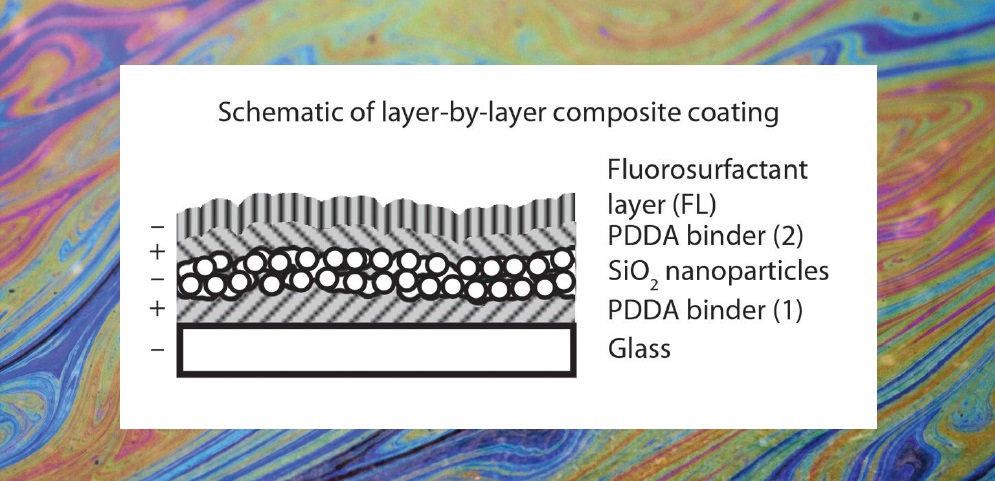‘Flip-flop’ coatings: Impart surface versatility
Dr. Neil Canter, Contributing Editor | TLT Tech Beat April 2016
A new method prepares all four coating types using a flexible, layer-by-layer spray-coating technique.
KEY CONCEPTS
•
A flip-flop coating is prepared by placement of different molecular functionalities at opposite ends of the coating.
•
Four possible flip-flop coatings have been developed through the use of a layer-by-layer deposition technique.
•
The coatings displayed good performance after being evaluated in a series of tests.
A VERY ACTIVE AREA OF RESEARCH IS THE DEVELOPMENT OF COATINGS that can render surfaces superhydrophobic. The objective from the lubricant standpoint is to facilitate water repellency so that problems that can occur during the operation of machinery—such as corrosion and premature lubricant failure—are minimized.
In a previous TLT article, a model was developed that explains the movement of a water jet on a superhydrophobic surface (
1). Researchers prepared a superhydrophobic surface that contains microscopic ribs and cavities. They found that better drag reduction and lower friction occurs if the water moves parallel to the ribs and cavities rather than perpendicular to them.
STLE Fellow professor Bharat Bhushan, Ohio Eminent Scholar and Howard D. Winbigler professor of mechanical engineering at The Ohio State University in Columbus, Ohio, says, “Four different coatings can be prepared that provide combinations of superhydrohilicity, superoleophilicity, superhydrophobicity and superoleophobicity. These coatings can be used to modify a surface so that it can attract or repel oil and water.”
Of interest to the lubricant industry is the potential use of a superhydrophilic/superoleophobic coating that repels oil and can be used as a way to clean up oil spills. One important concept is the use of a “flip-flop” coating that can allow water to penetrate but repel oil.
Bhushan says, “Flip-flop coatings enable the attraction of one type of liquid and the repulsion of a second type of liquid through positioning of different molecular functionalities at different ends of the coating. The use of a fluorosurfactant adhered to an omniphilic polymer creates this effect by having the high surface tension head groups near the polymer surface and the lower surface tension tail groups at the air interface. The result is that oil droplets are repelled by the tail groups, but water droplets penetrate through the coating to the head groups.”
In a non-flip-flop coating, the water molecules are not able to penetrate through the coating. Previous methods for developing flip-flop coatings have not worked due to a number of problems. Bhushan says, “In past work, researchers have tried to repel one liquid at a time but have encountered difficulties in preparing single-layer coatings. Developing a polymer binder that can hold all of the components in a coating together has proved difficult. Compatibility is a problem along with how to optimize the properties of the coatings.”
There is a need for a new technique for developing flip-flop coatings to exploit their versatility. Such an approach is now available.
LAYER-BY-LAYER DEPOSITION
Bhushan, in collaboration with his colleague, postdoctoral researcher Dr. Philip Brown, has developed a method for preparing all four coating types through the use of a flexible layer-by-layer technique. He says, “We found that coatings can be prepared by applying as many as four distinct layers in sequence to a glass slide with dimensions of 25 × 10 millimeters. The layers are each introduced through the use of a spray coating technique.”
The base layer is a polydiallyldimethylammonium chloride (PDDA) used as an anchor layer because it strongly adheres to glass. The second layer is untreated hydrophilic silica nanoparticles that impart roughness to the coating. Bhushan says, “Roughness is a key element that imparts toughness to the coating and ensures that the coating remains thin and transparent.”
The third layer is a second coating of PDDA which produces the superhydrophilic/superoleophilic coating. To prepare the other three coatings, the appropriate functional layer or top layer is introduced. In Figure 1, the top layer is a fluorosurfactant used in the superhydrophilic/superoleophobic coating.
 Figure 1. As many as four layers can be applied to form flip-flop coatings using a layer-by-layer deposition technique. The schematic shows the composition of a superhydrophilic/superoleophobic coating. (Figure courtesy of The Ohio State University.)
Figure 1. As many as four layers can be applied to form flip-flop coatings using a layer-by-layer deposition technique. The schematic shows the composition of a superhydrophilic/superoleophobic coating. (Figure courtesy of The Ohio State University.)
Bhushan says, “The overall thickness of these coatings is 630 nanometers, but it has not been optimized. We believe that thinner coatings can be made as part of improving the performance of these coatings.”
The researchers did a series of tests to analyze the properties and performance of the coatings. Among the test run is assessing the wear resistance of the coating using a ball-on-flat tribometer on the macroscale and on the microscale (with the assistance of an atomic force microscope). The coatings showed good performance compared to a soft coating containing PDDA and a functional layer.
The superhydrophilic/superoleophobic layer displayed good oil repellency by exhibiting a contact angle for hexadecane of 157 degrees. Bhushan says, “The No. 1 issue that we need to evaluate is the durability of the coatings.”
Coating applications are dependent upon the composition of the functional layer. Bhushan says, “One of the advantages of this layer-by-layer deposition approach is that one functional layer can be substituted for another to enable the end-user to tailor the properties of the coating to a specific application.”
The next area Bhushan intends to explore is impregnating particles into plastic sheets to improve their performance properties. Additional information can be found in a recent article (
2) or by contacting Bhushan at
bhushan.2@osu.edu.
REFERENCES
1.
Canter, N. (2014), “Gaining a better understanding of superhydrophobic surfaces,” TLT,
70 (8), pp. 10-11.
2.
Brown, P. and Bhushan, B. (2015), “Bioinspired, roughness-induced, water and oil super-philic and super-phobic coatings prepared by adaptable layer-by-layer technique,”
Scientific Reports,”
5: 14030, DOI: 10.1038/srep14030.
 Neil Canter heads his own consulting company, Chemical Solutions, in Willow Grove, Pa. Ideas for Tech Beat items can be sent to him at neilcanter@comcast.net
Neil Canter heads his own consulting company, Chemical Solutions, in Willow Grove, Pa. Ideas for Tech Beat items can be sent to him at neilcanter@comcast.net.